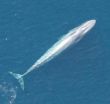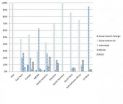(Press-News.org) The number of California blue whales has rebounded to near historical levels, according to new research by the University of Washington, and while the number of blue whales struck by ships is likely above allowable U.S. limits, such strikes do not immediately threaten that recovery.
This is the only population of blue whales known to have recovered from whaling – blue whales as a species having been hunted nearly to extinction.
Blue whales – nearly 100 feet in length and weighing 190 tons as adults – are the largest animals on earth. And they are the heaviest ever, weighing more than twice as much as the largest known dinosaur, the Argentinosaurus. They are an icon of the conservation movement and many people want to minimize harm to them, according to Trevor Branch, UW assistant professor of aquatic and fishery sciences.
"The recovery of California blue whales from whaling demonstrates the ability of blue whale populations to rebuild under careful management and conservation measures," said Cole Monnahan, a UW doctoral student in quantitative ecology and resource management and lead author of a paper on the subject posted online Sept. 5 by the journal Marine Mammal Science. Branch and André Punt, a UW professor of aquatic and fisheries sciences, are co-authors.
California blue whales ¬ are at their most visible while at feeding grounds 20 to 30 miles off the California coast, but are actually found along the eastern side of the Pacific Ocean from the equator up into the Gulf of Alaska.
Today they number about 2,200, according to monitoring by other research groups. That's likely 97 percent of the historical level according to the model the co-authors used. That may seem to some a surprisingly low number of whales, Monnahan said, but not when considering how many California blue whales were caught. According to new data Monnahan, Branch and another set of co-authors published earlier this summer in PLOS ONE, approximately 3,400 California blue whales were caught between 1905 and 1971.
"Considering the 3,400 caught in comparison to the 346,000 caught near Antarctica gives an idea how much smaller the population of California blue whales was likely to have been," Branch said.
The catches of blue whales from the North Pacific were unknown until scientists – in particular Yulia Ivashchenko of Southern Cross University in Australia – put on their detective caps and teased out numbers from Russian whaling archives that once were classified as secret but are now public. The numbers Russian whalers had publicly reported at one time were incomplete and inaccurate ¬– something that was admitted in the late 1990s – but there wasn't access to the real numbers until recently.
For the work published in PLOS ONE, the scientists then used acoustic calls produced by the whales to separate – for the first time – the catches taken from the California population from those whales taken in the western Northern Pacific near Japan and Russia. The two populations are generally accepted by the scientific community as being different. Places where acoustic data indicated one group or the other is present were matched with whaling catches.
In the subsequent Marine Mammal Science paper just out, the catches were among the key pieces of information used to model the size of the California blue whale population over time – a model previously used by other groups to estimate populations of hundreds of fish and various other whale species.
The population returning to near its historical level explains the slowdown in population growth, noted in recent years, better than the idea of ship strikes, the scientists said.
There are likely at least 11 blue whales struck a year along the U.S. West Coast, other groups have determined, which is above the "potential biological removal" of 3.1 whales per year allowed by the U.S. Marine Mammal Protection Act.
The new findings says there could be an 11-fold increase in vessels before there is a 50 percent chance that the population will drop below what is considered "depleted" by regulators.
"Even accepting our results that the current level of ship strikes is not going to cause overall population declines, there is still going to be ongoing concern that we don't want these whales killed by ships," Branch said.
Without ship strikes as a big factor holding the population back – and no other readily apparent human-caused reason (although noise, chemical pollution and interactions with fisheries may impact them) – it is even more likely that the population is growing more slowly because whale numbers are reaching the habitat limit, something called the carrying capacity.
"We think the California population has reached the capacity of what the system can take as far as blue whales," Branch said.
"Our findings aren't meant to deprive California blue whales of protections that they need going forward," Monnahan said. "California blue whales are recovering because we took actions to stop catches and start monitoring. If we hadn't, the population might have been pushed to near extinction – an unfortunate fate suffered by other blue whale populations."
"It's a conservation success story," Monnahan said.
INFORMATION:
Funding for students working on the research in Branch's lab comes through the Joint Institute for the Study of the Atmosphere and Ocean, a collaboration between the National Oceanic and Atmospheric Administration and UW.
For More Information
Monnahan, monnahc@uw.edu
Branch, tbranch@uw.edu
References
"Do ship strikes threaten the recovery of endangered eastern North Pacific blue whales?
Marine Mammal Science
Article under embargo until Sept. 5, 2014
Co-authors: Cole Monnahan, Trevor Branch and André Punt
Journal website: http://onlinelibrary.wiley.com/journal/10.1111/(ISSN)1748-7692
"Estimating Historical Eastern North Pacific Blue Whale Catches Using Spatial Calling Patterns"
PLOS One
June 3, 2014
Co-authors: Cole Monnahan, Trevor Branch, Kathleen Stafford, Yulia Ivashchenko, Erin Oleson
Article: http://www.plosone.org/article/info%3Adoi%2F10.1371%2Fjournal.pone.0098974
California blue whales rebound from whaling, first of their kin to do so
2014-09-05
ELSE PRESS RELEASES FROM THIS DATE:
Glanville fritillary genome sequenced at the University of Helsinki
2014-09-05
The Glanville fritillary has long been an internationally known model species for ecology and evolutionary biology, whose population biology has been studied on the Åland Islands for more than twenty years. Now the species has become even more significant. Led by Research Professor Ilkka Hanski, the Metapopulation Research Group (MRG) at the University of Helsinki has sequenced the full genome of the Glanville fritillary together with three groups from the Institute of Biotechnology at the same university.
Before the sequencing of the Glanville fritillary genome, which ...
Near-extinct African amphibians 'invisible' under climate change
2014-09-05
An international team of researchers has found that the majority of threatened species are 'invisible' when using modern methods to predict species distributions under climate change.
Using African amphibians as a case study, the researchers found that more than 90 per cent of the species listed as threatened on The IUCN Red List of Threatened Species are omitted by the most popular tools for species distribution modelling.
The study, led by researchers from the Universities of York and Copenhagen and the United Nations Environment Programme World Conservation Monitoring ...
Caffeine therapy for apnea of prematurity does not have long-term harmful effects on sleep
2014-09-05
Caffeine therapy for apnea of prematurity has no long-term harmful effects on sleep or control of breathing, according to a new study of 201 preterm children assessed at ages 5-12, the first study in humans to examine the long-term effects of neonatal caffeine treatment on sleep regulation and ventilatory control.
"Animal studies have suggested that administration of neonatal caffeine to premature infants, while improving survival and other outcomes, may have long-term detrimental effects on sleep and control of breathing during sleep," said lead author Carole L. Marcus, ...
Research finds no association between wearing a bra and breast cancer
2014-09-05
PHILADELPHIA — A population-based case-control study found no association between bra wearing and increased breast cancer risk among postmenopausal women, according to research published in Cancer Epidemiology, Biomarkers & Prevention, a journal of the American Association for Cancer Research.
"There have been some concerns that one of the reasons why breast cancer may be more common in developed countries compared with developing countries is differences in bra-wearing patterns," said Lu Chen, MPH, a researcher in the Public Health Sciences Division at Fred Hutchinson ...
Magnetic nanocubes self-assemble into helical superstructures
2014-09-05
Materials made from nanoparticles hold promise for myriad applications, from improved solar energy production to perfect touch screens. The challenge in creating these wonder-materials is organizing the nanoparticles into orderly arrangements.
Nanoparticles of magnetite, the most abundant magnetic material on earth, are found in living organisms from bacteria to birds. Nanocrystals of magnetite self-assemble into fine compass needles in the organism that help it to navigate.
Collaborating with nanochemists led by Rafal Klajn at the Weizmann Institute of Science in Israel, ...
A lifetime of outdoor activity may contribute to common eye disease; sunglasses may help
2014-09-04
BOSTON (Sept. 4, 2014) — Residential geography, time spent in the sun, and whether or not sunglasses are worn may help explain why some people develop exfoliation syndrome (XFS), an eye condition that is a leading cause of secondary open-angle glaucoma and can lead to an increased risk of cataract and cataract surgery complications, according to a study published on Sept. 4 in JAMA, Ophthalmology.
Despite improvements in understanding the cause of this common yet life-altering condition, more work needs to be done. "The discovery that common genetic variants in the lysyl ...
NASA sees Dolly's remnants bringing showers to the Rio Grande Valley
2014-09-04
Tropical Storm Dolly fizzled out quickly on September 3 after making landfall in eastern Mexico, and NASA's Aqua satellite saw some of the remnants moving into southern Texas. NASA's TRMM satellite analyzed the rainfall occurring in the storm as it was approaching landfall.
NASA's Aqua satellite captured the remnants of Tropical Depression Dolly over northeastern Mexico on Sept. 3 at 19:40 UTC (3:40 p.m. EDT). The image, captured by the Moderate Resolution Imaging Spectroradiometer or MODIS instrument showed the center of Dolly over northeastern Mexico with a band of thunderstorms ...
Hurricane Norbert pinwheels in NASA satellite imagery
2014-09-04
The Eastern Pacific's Hurricane Norbert resembled a pinwheel in an image from NASA's Terra satellite as bands of thunderstorms spiraled into the center. NASA's Global Precipitation Measurement or GPM mission has helped forecasters see that Norbert has lost some of its organization early on September 4.
The MODIS instrument or Moderate Resolution Imaging Spectroradiometer aboard NASA's Terra satellite captured a visible picture of Tropical Storm Norbert on Sept. 4 at 2:15 p.m. EDT when it resembled a pinwheel. The western bands of Norbert were moving over Socorro Island, ...
Climate-smart agriculture requires three-pronged global research agenda
2014-09-04
Faced with climate change and diminishing opportunities to expand productive agricultural acreage, the world needs to invest in a global research agenda addressing farm and food systems, landscape and regional issues and institutional and policy matters if it is to meet the growing worldwide demand for food, fiber and fuel, suggests an international team of researchers.
In a paper appearing online in the journal Agriculture and Food Security, the authors summarize the findings of the second international Climate Smart Agriculture conference held in March 2013 at UC Davis.
"Climate-smart ...
News media losing role as gatekeepers to new 'social mediators' on Twitter, study finds
2014-09-04
The U.S. government is doing a better job of communicating on Twitter with people in sensitive areas like the Middle East and North Africa without the participation of media organizations, according to a study co-authored by a University of Georgia researcher.
The study looked at the U.S. State Department's use of social media and identified key actors who drive its messages to audiences around the world. In particular, it examined the role played by news media and the government in bridging the State Department communication with people domestically and internationally. ...






